Dès sa sortie en décembre 2022, Avatar : La voie de l'eau a attiré l'attention de la communauté des plongeurs pour ses remarquables scènes sous-marines. Curieux de découvrir les coulisses de la maîtrise technique de ces scènes, je me suis entretenu avec le producteur Jon Landau, le moniteur d'apnée Kirk Krack, le directeur de la photographie sous-marine Pete Zuccarini et le maître-plongeur superviseur et responsable de la sécurité John Garvin.
The sequel to 2009’s Avatar introduces the Metkayina, Na’vi who are born in the ocean and have adaptations such as tails shaped to help enhance in-water propulsion and eyes that provide better underwater vision. They move through the water much like freedivers without fins. The in-water skills the Metkayina characters demonstrate are rooted in hydrodynamics. Landau explained this quest for authenticity in greater detail.
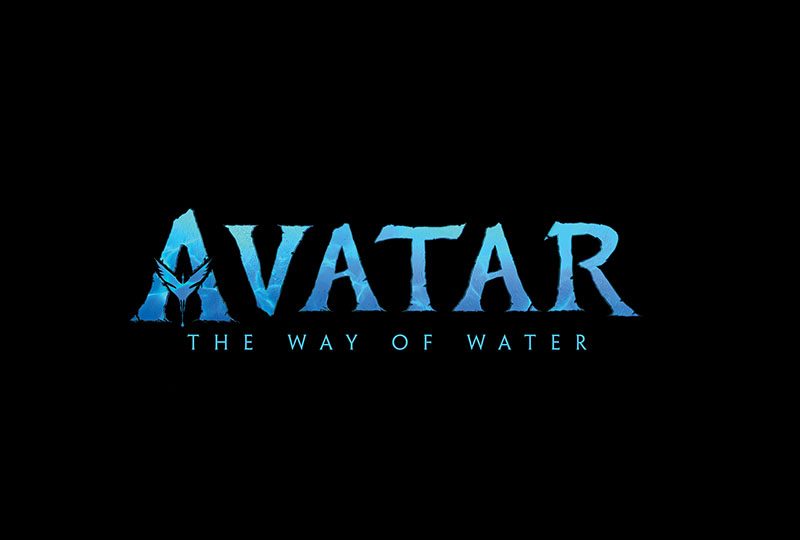
Quel a été le processus de réflexion qui a conduit à la réalisation d'un film entièrement sous-marin ?
Jon Landau : The first thought was the story. Going into the sequel, we saw the ocean as a transportive journey for our audience to go to the incredible places you’ve been to or that I’ve been lucky enough to dive, and for sure those Jim Cameron has explored. Pandora is a world with water, like Earth. Not all of this film is underwater, of course, but as we saw from the first movie’s fantastical forest and floating islands, there is also a great deal of joy and wonder in the oceans of Pandora.
Think about when you swim around a reef structure and suddenly see a manta ray or a whale shark. You’re amazed! We wanted to take what ocean life has shown us and stand it on its tail. We know from experience what a sperm whale looks like underwater, and we wanted our whale variants, the tulkun, to grow to 300 feet (91 meters) long and have amazing new functionalities and a spiritual relationship with the Metkayina. That was the kind of ocean environment we envisioned.
I saw that in your coral reef. The fish were generally similar to fish we see on Earth, as if they had some distant relation to jacks, butterflyfish, and jellyfish. We saw the basic forms of sharks, whales, eels, and even a flying fish, but clearly different. This isn’t your first splash into underwater films. Jim made Le gouffre en 1989, et vous avez collaboré avec lui sur Titanic en 1997. Il y a eu beaucoup de travail sur l'eau dans ce cas.
Yes, but this one has something Titanic did not: breath-hold diving! When Jim approached Sigourney Weaver to do this movie, he told her she needed to be able to hold her breath for three minutes to do a scene. She said, “Jim, I can’t hold my breath for 30 seconds.” Yet eventually she could do much more than that, working her way up to five minutes of static apnea.
You’ve seen movies that are dry-for-wet; Aquaman is an example. The underwater scenes are typically simulations in front of a green screen, and performers levitate on cables to approximate what they might look like moving within an environment more than 800 times denser than air. Wind machines blow their hair, and computer-generated imagery techniques are added during postproduction. That was not good enough for Jim. He wanted the authenticity of wet-for-wet, which meant that everyone — actors and camera crew — had to be skilled freedivers.
La technologie existe depuis suffisamment longtemps pour que vos lecteurs connaissent probablement la capture de performance. Vous reconnaissez sans doute les perles rondes cousues sur les costumes dans les coulisses des films de Avatar or other movies. But now the reflective marker dots would be on wetsuits, and the underwater cameras can’t really differentiate between a marker on an actor’s suit or an exhaust bubble from a scuba regulator.
As Jim explained it, “Everybody who was working in the tank was holding their breath. If there was someone down there holding a light, they were holding their breath. If they were operating a camera, they were holding their breath. The actors, of course, had to be holding their breath.” That bit of physics — the inability to differentiate between a performance-capture suit marker and an exhaust bubble — is why Avatar : La voie de l'eau devait être un film sur la plongée en apnée.
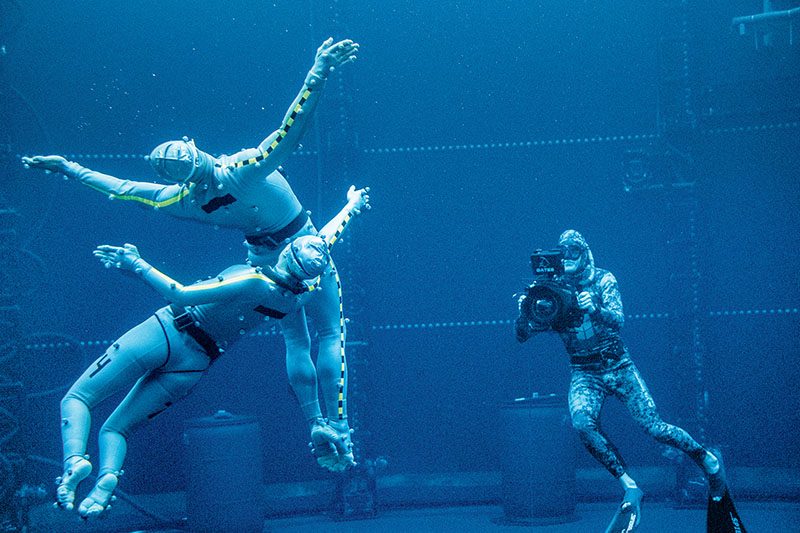
Formation Acteurs et équipe
Pour mieux comprendre l'aspect apnée du film, j'ai interviewé Kirk Krack, fondateur de Performance Freediving International. Au cours des cinq dernières années, il a été intimement impliqué dans l'établissement de protocoles et dans la formation des acteurs et de l'équipe afin qu'ils puissent atteindre les niveaux élevés d'efficacité en matière d'apnée requis pour ce film.
I learned about the huge tanks you were using for filming. The tank at production company Lightstorm Entertainment’s Manhattan Beach, California, studio was 120 feet (36,6 meters) long, 60 feet (18 meters) wide, and 30 feet (9 meters) deep. It held more than 250,000 gallons (946.353 litres) of water and could simulate waves breaking on the shore. That was just one of the six tanks, so this film had significant in-water infrastructure. I understand why bubbles were an issue for the wet-to-wet film technique, but couldn’t rebreathers have worked as well?
Kirk Krack : In shallow water, rebreathers aren’t necessarily totally bubble-free. Even more important, the Metkayina have evolved for life in the sea, so they needed to move like freedivers. The underwater “volume” (the name for performance-capture stages) was a huge tank with 200 cameras mounted at three levels plus the cameras that Pete Zuccarini and the assistant camera operators were shooting. We couldn’t have some people on scuba, some on rebreathers, and some freediving. With that as the prerequisite, we had to consider what it would take to make everyone in the tank into freedivers.
I saw it as a two-pronged approach. We’d have to start with a training regimen to make the cast, crew, and camera operators into freedivers if they weren’t already, and if they were, make sure they would follow the same protocols as our new freedivers. Once we were filming, we utilized technical freediving to enhance performance capabilities. At times, people in the tank might be prebreathing 50 or 80 percent nitrox before their freedive performances. Being on the set made everyone appreciate the cutting-edge technology necessary to bring the ideas to fruition.
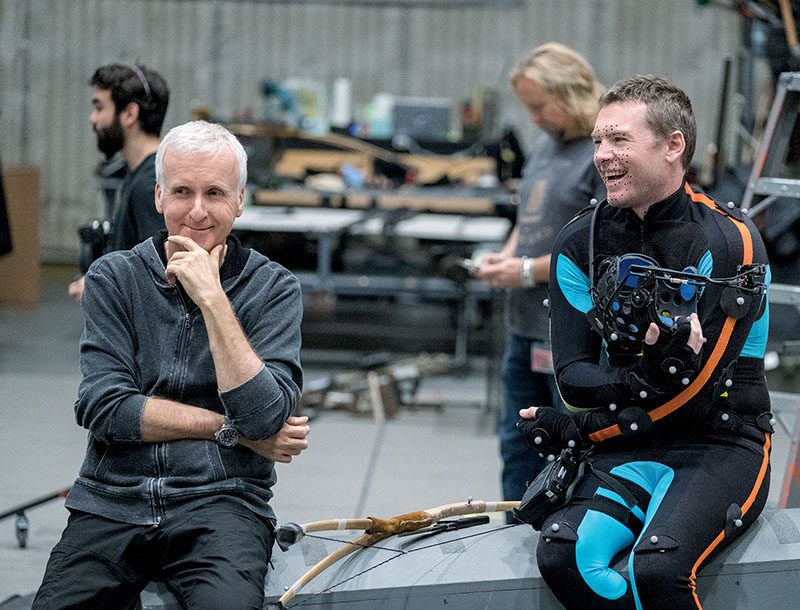
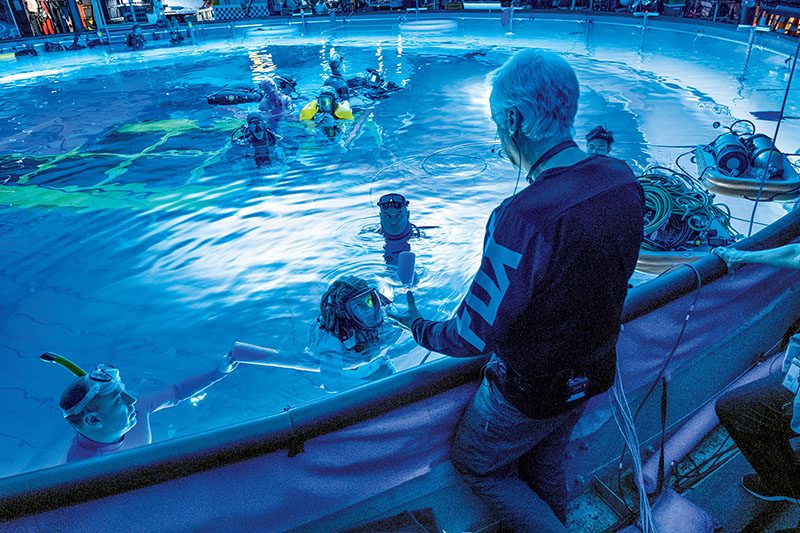
J'ai lu des informations sur cette technologie dans les notes de production. Cameron a déclaré que sa caméra virtuelle intégrait les deux volumes de capture de la performance (aérien et sous-marin) en temps réel.
The virtual camera was especially mind-boggling. You had all these cameras filming people with marker dots moving in a tank, yet on the topside monitor we saw them swimming in the surreal Pandoran sea in real time. It was a unique form of moviemaking. I predict the upcoming film awards season will fully recognize this film’s degree of technical achievement.
There was something special about this project. Cameron’s demands for perfection meant we had time and motivation to thoroughly train the people involved. Some of the cast and crew were water savvy, but some were almost afraid of the water. We had the luxury of concentrating on freediving theory, water safety, and technique. We had to make them such good freedivers they could go beyond merely holding their breath. They couldn’t look like they were trying to survive; they had to be able to act.
It was quite challenging for me and the stunt performers. I often did more than three hours of breath-hold diving in a 12-hour workday. At 6 a.m. I might be up vacuuming the tank, and at the end of the day we’d blend the nitrox for the next shoot day. We had up to 30 people in the water at once and logged more than 250,000 freedives on this movie. All the actors could do more than four minutes in static apnea, and Kate Winslet could do more than seven minutes!
Comment cela s'est-il passé concrètement ? Tout le monde à la surface attendait-il l'appel de Jim ? “action,” and then you all dived to shoot?
No, it was exactly the opposite. All 200 people working on the scene would be waiting on us. Our freedive performance was the linchpin. We’d count down to our signal to dive after we’d prebreathed and established comfort level for performing. We used technical freediving with nitrox to reduce hypoxia risk, recover more rapidly, and become comfortable enough with the in-water experience to act.
Filmer les apnéistes
Lorsqu'un film hollywoodien à gros budget a besoin d'un caméraman sous-marin, Pete Zuccarini a toutes les chances d'être appelé à la rescousse. Il n'est pas surprenant que Zuccarini ait été impliqué lorsque Cameron a recruté les meilleurs talents pour ce projet. Le fait qu'il soit un apnéiste talentueux a sans doute aidé. Même si la capture de performance pour Avatar : The Way of Water a commencé en septembre 2017 et a duré environ 18 mois, Zuccarini a rejoint le projet en avril 2017.
Typique de la préparation d'une production de James Cameron, Zuccarini a été appelé pour tourner des essais dans différents environnements, notamment dans le port de San Pedro, sur l'île de Catalina et aux Bahamas. Aux Bahamas, ils ont filmé le recordman de plongée en apnée William Trubridge sans palmes afin d'étudier et de prendre en compte sa technique.
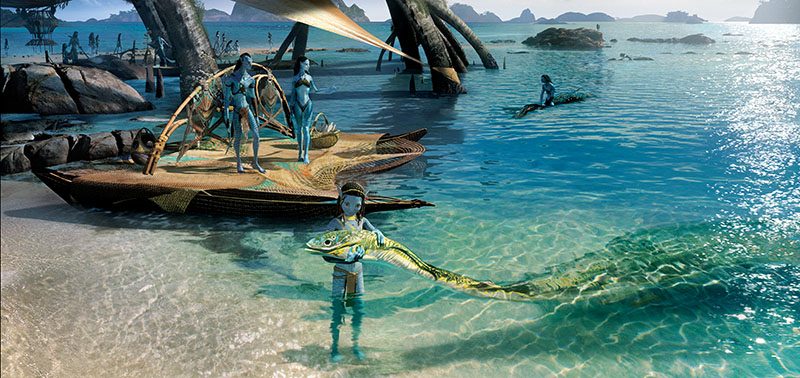
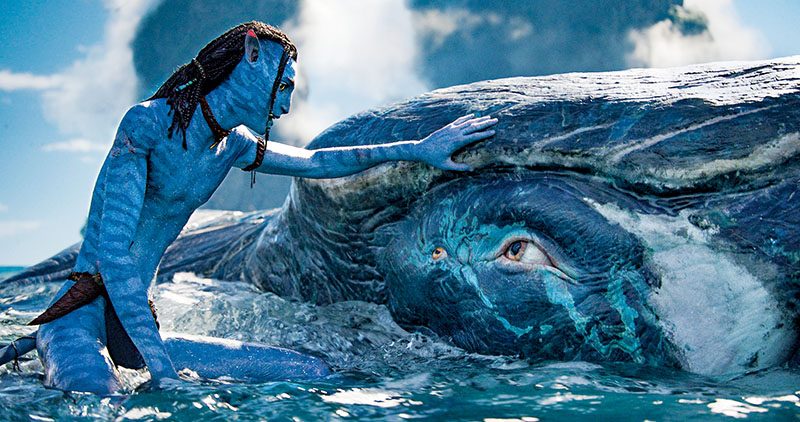
It seems like there are scenes in the movie that someone who isn’t a diver and hadn’t seen such an interplay of light somewhere beneath the sea couldn’t have scripted. James Cameron, in particular, has apparently been diving with a different objective over the years, for I see decades of studying light underwater in every frame.
Pete Zuccarini : L'interaction de la lumière à différentes profondeurs et dans différents états de la mer a en fait été scénarisée. Lors de nos tests en pleine mer aux Bahamas, Jim m'a demandé de filmer des éléments très spécifiques en 8K à des fréquences d'images élevées. Nous avons étudié la manière dont la lumière filtrait à travers la colonne d'eau sous l'effet de fortes houles, de surfaces agitées par le vent et de surfaces vitreuses et lisses. Nous avons capturé les qualités de la lumière se dispersant à travers les particules et la façon dont les motifs de réfraction jouent sur le substrat benthique à différentes profondeurs.
The visual effects team pretty well understood the filtering of color wavelengths at different depths, so we were going after more subtle physics details, such as the way sand was twirling off the tops of the ripples in the sand under the waves. We looked at how swell and turbulence moves things such as hair, clothing, skin, and seagrasses. These high-resolution real ocean images provided reference data to better inform and communicate with the visual effects team responsible for creating Pandora’s ocean.
Pour éprouver la sensation de chevaucher un grand et puissant animal aquatique en pleine mer, l'équipe de cascadeurs a créé des répliques mécaniques du tulkun, de l'ilu et du skimwing. Ces créatures mécaniques ont été remorquées par des bateaux ou propulsées par un appareil à réaction exclusif afin de simuler le mouvement et la maniabilité des créatures que vous voyez dans le film.
An underwater stunt “driver” and another stunt performer would hang on rodeo-style at incredibly high speeds. The velocity of the rapid ascents and descents required the stunt team to accomplish unprecedented feats of breath-holds, equalization, and strength. Imagine riding a creature with enough inertia to go from underwater, jump 12 feet (3,6 meters) out of the water, and then descend in seconds to a depth of 40 feet (12 meters). All the while the stunt performers were doing hand signals and facial expressions to remain in character while traveling 5 knots underwater.
Jim souhaitait que des caméras de référence enregistrent chaque instant de ces courses sous plusieurs angles. En plus de fixer des caméras d'action sur les créatures et les cascadeurs, nous avons installé deux véhicules à propulsion de plongée (DPV) extrêmement rapides pour suivre l'action. J'ai travaillé en tandem avec Charlie Arneson pour suivre l'action sous l'eau. Ces traîneaux à caméra étaient suffisamment rapides pour nécessiter un capotage afin d'éviter que nos masques de plongée ne soient arrachés de nos visages.
J'ai utilisé un pince-nez spécial qui m'a permis d'égaliser mes oreilles et mon masque en gardant les mains libres. La nécessité de suivre le sujet dans les ascensions rapides et de rester aérodynamique et agile nous imposait d'opérer en apnée. À partir de ces tests, Jim a affiné ce qu'il voulait voir dans la conception et l'utilisation du réservoir de capture de performance que Lightstorm a construit dans les studios de Manhattan Beach.
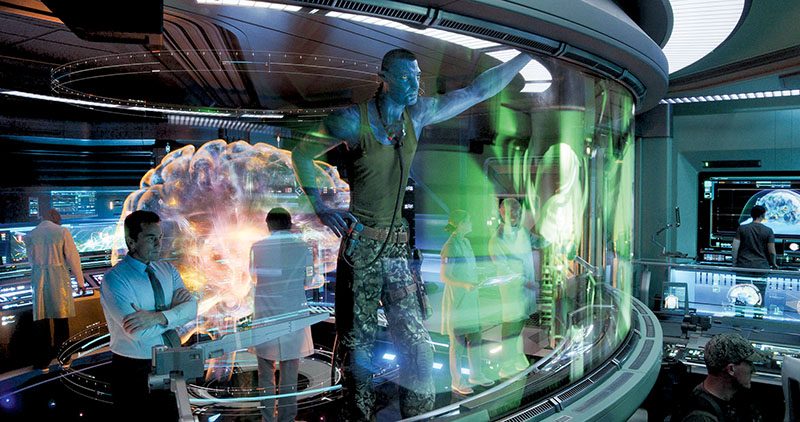
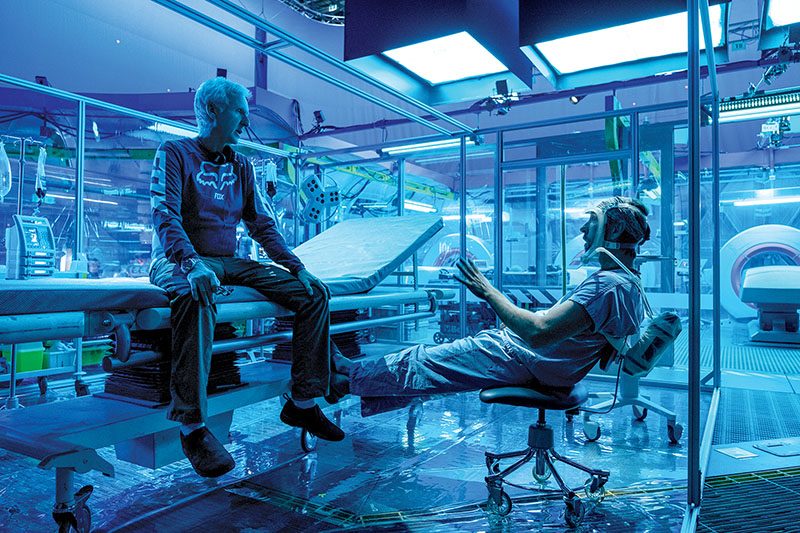
Superviser la sécurité
One of the most important people on this film was John Garvin, who oversaw the tens of thousands of scuba dives and hundreds of thousands of freedives over the four years of shooting. Up to 30 divers — stunt performers, grips, lighting technicians, camera operators, safety divers, and actors — could be working in the tank at any given time. The work was often spread among a dozen different dive teams in a rapidly changing environment. No one got hurt on the production, which says a lot about Garvin’s professionalism and commitment.
Ce que vous avez dû faire semble être un défi de taille. Comment avez-vous procédé ?
John Garvin : Ma première tâche a été de rédiger notre manuel d'opérations de sécurité en plongée. Nous devions définir les risques et les atténuer. Le service d'éclairage devait monter et descendre dans la colonne d'eau. Nous avons donc adapté les tables de plongée Tasmanian Bounce pour nos mélanges nitrox. Nous avions des ordinateurs de plongée à chaque poignet et, bien que la maladie de décompression ne soit pas notre première préoccupation, elle peut survenir lorsque l'on passe jusqu'à 12 heures par jour dans l'eau. Chaque réservoir de production a fait l'objet d'exercices d'urgence spécifiques en fonction de ses caractéristiques.
Nous avons également consulté les meilleurs experts dans leurs domaines de spécialité, tels que Neal Pollock, PhD, et Simon Mitchell, MB ChB, PhD. Un autre principe de notre approche était d'apprendre de nos erreurs en cours de route. Nous n'avons jamais eu d'évanouissement en eau peu profonde, mais nous avons eu une perte de contrôle moteur à la surface au début du processus. Cet incident nous a appris qu'il était nécessaire de prérespirer du nitrox. Notre objectif de base était d'atteindre une durée d'apnée de deux minutes pour chaque acteur, ce que nous avons réussi à faire. Les Metkayina étant nés dans l'eau, l'autre objectif essentiel était que tous les acteurs aient l'air à l'aise sous l'eau, comme s'ils étaient eux aussi nés dans l'eau.
Y a-t-il un risque spécifique lié au réservoir qui vous a empêché de dormir, vous demandant comment l'atténuer ?
Les boules de diffusion qui flottaient à la surface m'ont causé beaucoup d'inquiétude. Si elles avaient la taille idéale pour transmettre la lumière et permettre au plongeur de se frayer un chemin jusqu'à l'air, elles avaient également la taille d'une trachée. Les plongeurs devaient non seulement remonter à la surface, mais aussi lever la tête à travers la couverture de 7,6 centimètres de ces boules pour respirer. Nous avons préparé des protocoles de sécurité en cas d'ingestion. Malgré toutes les innovations technologiques de ce film, nous dépendions tous d'une nouille de piscine $2 sur laquelle les acteurs pouvaient se reposer à la surface.
How did you communicate underwater? I can’t imagine hand signals were enough for a project this complex.
I give a huge shoutout to Ocean Technology Systems. The set was quite noisy underwater, yet everyone had to follow their team’s directions. That meant operating on different channels with multiple hydrophones and noise gates. The grips had to constantly talk to each other to do their job, for example, but the actors needed to hear Jim.
His communication with the actors was invaluable because Jim is a tremendously experienced diver. He knows that water dictates movement. You can’t fake that. Even nondivers in the audience will intuitively pick up on underwater physicality that isn’t right for some reason, which then severs the emotional attachment. That’s why this film is wet-for-wet. We hope it will resonate with anyone who deeply loves the ocean, but it will be particularly relatable to divers.
We did everything underwater that you see underwater in this film. The team came to understand the technical challenges of bringing James Cameron’s vision of underwater Pandora to life. Yet, as Landau pointed out, while the ocean provided the backdrop to tell the story, the story was still paramount. Our job was to collaborate with Jim, the entire crew, and the actors to bring the underwater visuals of that story to life.
En savoir plus
En savoir plus sur l'élaboration de Avatar : La voie de l'eau dans ces vidéos.
© . - Q1 2023